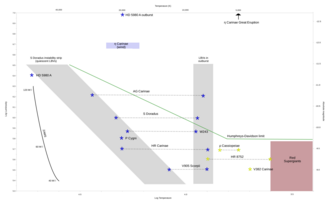R71 (star)
| Observation data Epoch J2000 Equinox J2000 | |
|---|---|
| Constellation | Mensa |
| Right ascension | 05h 02m 07.394s[1] |
| Declination | −71° 20′ 13.12″[1] |
| Apparent magnitude (V) | 8.7[2] - 9.9[3] - 11.2[4] |
| Characteristics | |
| Spectral type | LBV |
| U−B color index | −0.63[5] |
| B−V color index | +0.05[5] |
| Variable type | LBV[2] |
| Details | |
| Quiesecent | |
| Mass | 27[2] M☉ |
| Radius | 107[2] R☉ |
| Luminosity | 603,000[2] L☉ |
| Surface gravity (log g) | 1.80[2] cgs |
| Temperature | 15,500[2] K |
| Outburst 1975 | |
| Luminosity | 830,000[3] L☉ |
| Temperature | 12,600[3] K |
| Outburst 2012 | |
| Radius | 500[6] R☉ |
| Luminosity | 1,050,000[6][2] L☉ |
| Temperature | 6,650[6] K |
AAVSO 0503-71, 2MASS J05020738-7120131 | |
| Database references | |
| SIMBAD | data |
R71 (RMC 71, HD 269006) is a star in the
History of observations
R71 has long been known as a blue supergiant and one of the brightest stars in the Magellanic Clouds. It was given a spectral type of B2.5 Iep.[7]
By 1974, R71 had increased in brightness from about 11th magnitude to about magnitude 9.2, and examination of historical photographic plates showed that there had been similar changes in the past, with the brightness peaking around 1914 and 1939.
The outburst of R71 lasted from about 1971 until 1977, and it then faded back to about 11th magnitude. Records are incomplete, but a new outburst was observed to begin in 2006 with the brightness increasing beyond any previous observations to magnitude 8.7. The temperature also cooled to record levels around 6,650 K and the luminosity was calculated to have increased significantly.[6] During the rise of this outburst, periodic brightness variations with an amplitude of about 0.1 magnitudes began to be seen.[2]
Spectrum

The spectrum of R71 in quiescence (minimum brightness) shows weak
During the 1970s outburst, many spectral lines developed strong
In 2012, at the peak of the unusually bright outburst, the Hα lines developed into double-peaked
Variability

R71 show brightness variations in many ways typical of the luminous blue variable group of variable stars: long periods near a minimum brightness known as quiescence; micro-variations of less than 0.1 magnitude during the quiescent periods; and outbursts of a magnitude or more lasting several years at intervals of a few decades.[3] At quiescence the star is around magnitude 11, with the lowest brightness recorded at about magnitude 11.2. The 1914, 1939, and 1970s outbursts reached approximately magnitudes 10.2, 9.9, and 9.8 respectively.[4]
The outbursts of R71 have apparently been getting progressively brighter, albeit from only a handful observed, with the 2012 outburst being unusually bright for this class of variables, reaching a peak of magnitude 8.7. It is also unusual in that periodic variations of about 0.2 magnitudes developed during the rise to maximum brightness. The period of these variations increased as the brightness increased until it was around 425 days.[2]
Properties

R71 is one of the most luminous stars known, and the most luminous in the Magellanic Clouds during the 2012 outburst.[4] During quiescence, it appears as like other very luminous early B supergiants, about 15,000 K and 600,000 L☉. The radius of this type of stars is not well-defined as it has a dense stellar wind and is losing mass at about one M☉ every three million years. The standard definition of a stellar surface at optical depth of 2/3 gives a radius of 107 R☉, but a more realistic definition of the surface for this type of star is at optical depth of 20 which gives a radius of 97 R☉.[2]
During an outburst, R71 cools and expands although the bolometric luminosity does not change greatly, which is typical behaviour for a luminous blue variable. Because of the cooler temperature, more of the
The brightness variations shown during the unusually cool outburst may be related to those shown by Cepheid variables and RV Tauri variables. The particularly low temperature brings R71 close to the instability strip where temperature-related opacity changes in the atmosphere cause regular pulsations.[2]
Evolution
Luminous blue variables have traditionally been considered to be in a short-lived unstable transition state before a massive star becomes a Wolf–Rayet star. This has been challenged by the theory that LBVs are the result of binary mass transfer with the mass gaining star becoming a massive and unstable luminous blue variable. R71 appears to be a very massive star that did not form within a mass star cluster, making it likely that it did not initially form as a very massive star. Instead it may have become massive later by gaining mass from a companion.[2][10]
For either formation method, the next stage of evolution for R71 is likely to be a hydrogen-free Wolf-Rayet star. Eventually it is inevitable that its core will collapse, which may result in a supernova. However, a proportion of stars similar to R71 appear to undergo progressively more violent outbursts until they are destroyed. Also, some or all Wolf–Rayet stars may collapse directly to a black hole without producing a bright supernova explosion.[2]
References
- ^ S2CID 244398875. Gaia DR3 record for this source at VizieR.
- ^ S2CID 54585370.
- ^ .
- ^ .
- ^ Bibcode:2002yCat.2237....0D.
- ^ S2CID 67775752.
- .
- ^ .
- ^ Bibcode:1981A&A...103...94W.
- S2CID 119474184.

